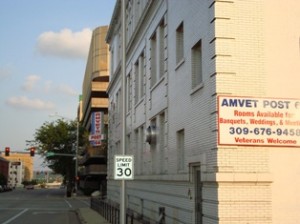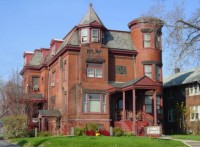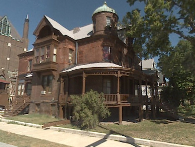According to this week’s “Issues Update” from the City, historic landmark applications in Peoria are up.
“In the past two years, 2007 and 2006,” the report states, “a total of two landmark applications were filed for Irving School and Glen Oak Park.” In 2008, however, there have been four: Amvets Post #64 (237 NE Monroe), Hamilton Boulevard, 401 NE Monroe, and Family House Peoria (1509 N. Knoxville).
For those of you who can’t picture these buildings, here they are — respectively, the Amvets building, Family House, and 401 NE Monroe:



Generally, I see this as a good thing. Too much of Peoria’s history has already been razed. What’s left really should be preserved — presuming, of course, that it meets reasonable standards for preservation. Most of these properties do.
The one exception would be Hamilton Boulevard. This is on the council’s agenda for Tuesday night. What they are actually proposing be given landmark status is “the built median component of the right-of-way, located within Hamilton Boulevard, from Monroe Street to Glendale Avenue, and Randolph Avenue to North Street.” To which I ask, The median? Really?
The justification for this appears to be the fact that the street was laid out by William S. Hamilton, son of Alexander Hamilton (you remember Alexander Hamilton — the guy on the $10 bill, first Secretary of the Treasury, died after famous duel with Aaron Burr). Okay, sure, William Hamilton is a prominent historical figure in Peoria. But he also laid out Water, Washington, Adams, Jefferson, Madison, Monroe, Liberty, Main, and Fayette. Should we also landmark all of those streets?
Besides, they kind of undercut their whole preservation argument when they removed the portion of Hamilton that is slated to be changed for the Methodist Hospital expansion. Les Kenyon of the Central Illinois Landmark Foundation (CILF) is quoted in the Historic Preservation minutes as saying:
…they [CILF] are satisfied that Methodist Hospital will provide a beautiful environment for patients, medical staff and visitors as they travel on the Hamilton corridor. He went on to say that for this reason, they have amended their original position with regard to Methodist Hospital’s plans and withdraw any objection to the Methodist Plan regarding landmarking Hamilton Boulevard through the Methodist campus and want to remove the Methodist campus from their landmark request.
But Methodist Hospital is removing the built median that CILF wants to see landmarked on the rest of the boulevard. So, is it historic or not? And Methodist is narrowing Hamilton where it passes their institutional zone. So, is the width of the street worth preserving or isn’t it? If Methodist’s plans for Hamilton don’t destroy the historic nature of the boulevard, then nothing does, and thus it needn’t be landmarked.
But don’t get me wrong. Even though I question this one landmark request, overall I think preserving Peoria’s built history is important. I was recently reading some newspaper clippings about the razing of the Rialto Theater to make way for the Civic Center, and it made me sad. It was one of Peoria’s original vaudeville houses. Originally called the Hippodrome, it housed many famous acts, as did the Palace Theater which was also razed about the same time. Whereas other cities, like Chicago, preserve their historic theaters, Peoria tore theirs down and felt the Civic Center theater was an adequate replacement. What a shame.
I’ve often joked (morbidly) that any history museum in Peoria should include an interactive exhibit where visitors can sit in a little crane and swing a wrecking ball into models of Peoria’s historical landmarks. It would be an object lesson in how little we value our history.

One of the down-sides to living in a town that Caterpillar calls its “World Headquarters.” We’ve been raised in an environment in which if it can be knocked down, and bulldozed… we’ll find a way to do it. You don’t sell many tractors by preserving your historical buildings.
Let me re-phrase that: You sell more tractors if you don’t preserve your historic buildings.
Can anyone recite the significance to the Amvet Post? I know up until the middle 60’s it was the home of Humi-tube Mfg which made cigar wrappers and Easter egg green “grass”, but what makes Kenyon get his shorts in such a knot about it?
The building having been the home of “Humi-Tube Mfg.” isn’t enough? Good Lord, man! Have you no sense of History, with a capital “H”?!?
Peoria and many other cities across the country lost a lot of their history when the word “progress” came into focus. Everywhere for decades things were knocked down and obliterated in the name of progress. It wasn’t until it was too late that we discovered what we were doing and what we were losing. So it is necessary to save what we can now because progress has almost completely destroyed our roots and our history all over the country. Les Kenyon is very devoted to preserving our history here in Peoria and he knows the history of every important building or place in the area. The CILF is a very devoted group of people and they are not there for their own gain, but for our preservation.
We can give Les his due, but he has been around a long time. A few key ‘monuments’ of historic note have slipped through his fingers [not to mention the fingers of Lakeview, Peoria Hist Society, etc.]. Les needs help…or at least someone else to pick up the gauntlet. We are still quibbling over millions and this idiotic museum, while our real history is disappearing-mostly because it is in the hands of the idiots running the idiotic museum project!
Are you sure?
The white building was the DUROC building – where USA hogs were registered. It might have been Humitube, but I don’t think so. I remember the Humitube building as being yellow or brown brick and I think it was on Madison where the Holiday Inn is located.
The Rialto and The Hippodrome were not the same. The Hippodrome was across the street connected to the Jefferson Building. WMBD studios were there in the good old days.
Les Kenyon wanted to preserve the Rialto and make it the CivicCenter theater. It was no more “preservable” than, say. the Landmark Theaters are today.
As for what is gone because of the Cat building? Not much. I do miss Plato Billiards where I misspent my youth.
I am surprised that Mr Kenyon did not try to save the old jail. It was on Hamilton and house many people who were more prominent that Mr Hamilton [well maybe].
Would I be correct in assuming that the landmark status would make it more difficult for anybody wanting to purchase the AmVet building to fix it up. The building has been on the block for awhile now. It’s a very plain interior with many problems that need to be addressed.
I’m all for keeping places with historic significance and century old quality craftsmenship, but this place doesn’t seem to have it.
John33 says: “The Rialto and The Hippodrome were not the same.”
Yes, they were. This can be confirmed by many, many newspaper accounts. I’ll just quote one — from Bill Adams’ “Yester Days” column, May 29, 1989:
WMBD studios were in the Majestic theater, not the Rialto. Landmark Cinemas are not in the same league as the Rialto; I don’t understand how one could even make a comparison.
The Amvets building is ready to fall apart. It will soon be purchased by Riverside Community Church, it’s neighbor, razed to make room for a children’s wing for the church. It will surely be put to better use by the church then the mess that stands there now.
You may be right about the Amvets building; it was just recently submitted, and I haven’t been able to read what it is about that building that should be preserved. I’ll withhold judgment on whether that’s a good candidate for preservation until I hear their argument for it.
Usually, preservation only focuses on the exterior. Technically, the landmark status shouldn’t make it more difficult to do structural improvements or interior improvements. Also, the federal government gives a 20% income tax credit to those who do any improvements, interior or exterior, according to the historic guidelines.
So, it can be a fiscally responsible way to preserve an old building, save the history (whatever history is associated with the building) and reuse an old structure. There are studies floating around that show that often, reuse and restoration is cheaper and more cost effective than tear-down rebuild. Unfortunately, the cost savings usually comes over time– not immediately.
historic preservation is more than just saving buildings.
which is not to say that buildings are not important.
They are. I vehemently disagree with those who say, when
a building is lost, “it was just a building”. A building is
all that has happened in it; all those who have been in it;
it is a treasure trove of memories and emotions, and a
connection between generations.
But historic preservation must extend beyond that.
It’s about preserving ways of life; methods of doing things,
preserving what makes our community unique.
We want to promote tourism, yet we have what to offer?
rubber tired “trolleys” and chain hotels. We haven’t really
developed and promoted what little we have, like Wildlife
Prairie Park. If you look at where the growth
in tourism is, it’s in “experience”, in learning and doing programs.
“living history” programs are poplular; “entertainment farming”
is booming, or mountain climbing; or dive vacations.
What is our community got to offer? More fast food joints per
capita than any other community in the country?
Ben you are right that the Amvets Bldg does need alot of work, but when you refer to the mess that stands there now, I hope you are only talking of the bldg and not of the members of the Amvets.They do alot of good work for the Vets and this community. Food baskets for the shut ins, college scholarships,transportation to hospitals out of this area for Vets,St. Judes and a host of other charities. But most people think it is just a bar,amazing.